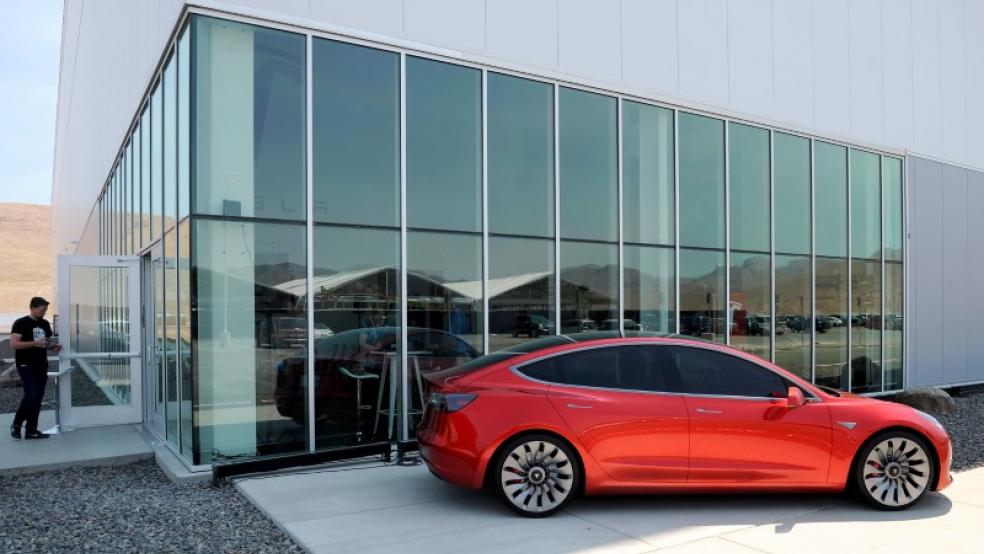Tesla fired up the gigafactory in the first week of 2017, which could mark a turning point for the energy storage industry.
The gigafactory in Nevada will begin mass production of lithium-ion batteries for the use in both Tesla’s Model 3 electric vehicle as well as its energy storage systems. Tesla, and its partner in the gigafactory, Panasonic, plan on hiring 4,000 people to work at the factory in 2017. By 2018, Tesla predicts that it will be churning out 35 gigawatts of lithium-ion batteries per ear, equivalent to what the rest of the world produces combined. In other words, this single factory will lead to a doubling of global battery production capacity next year.
Related: Elon Musk Outlines His Master Plan for Tesla, but Can It Be Done?
Up until now, battery production has been dominated by companies outside the United States. An estimated 88 percent of battery production in 2015 was located in China, South Korea and Japan, dominated by companies like LG Chem and Samsung. That market share distribution is set to abruptly change with the inauguration of the gigafactory.
Ramping up battery production to such a monumental degree will certainly lead to cost reductions for batteries. Increased automation, standardization, economies of scale, learning-by-doing, and a lower capital investment per watt-hour of production will likely lead to industry-wide cost reductions.
Tesla fired up the gigafactory in the first week of 2017, which could mark a turning point for the energy storage industry.
The gigafactory in Nevada will begin mass production of lithium-ion batteries for the use in both Tesla’s Model 3 electric vehicle as well as its energy storage systems. Tesla, and its partner in the gigafactory, Panasonic, plan on hiring 4,000 people to work at the factory in 2017. By 2018, Tesla predicts that it will be churning out 35 gigawatts of lithium-ion batteries per ear, equivalent to what the rest of the world produces combined. In other words, this single factory will lead to a doubling of global battery production capacity next year.
Related: Will Cheaper Oil Burn Tesla?
Up until now, battery production has been dominated by companies outside the United States. An estimated 88 percent of battery production in 2015 was located in China, South Korea and Japan, dominated by companies like LG Chem and Samsung. That market share distribution is set to abruptly change with the inauguration of the gigafactory.
Ramping up battery production to such a monumental degree will certainly lead to cost reductions for batteries. Increased automation, standardization, economies of scale, learning-by-doing, and a lower capital investment per watt-hour of production will likely lead to industry-wide cost reductions.
The end result could be cheaper EVs in the years ahead. Battery prices plunged 22 percent last year and are expected to decline by an additional 15 to 20 percent this year, according to Bloomberg New Energy Finance.
The doubling of global battery production capacity could not only lead to an acceleration in the EV market, but it is also leading to a massive bull run for another sector: lithium. According to the Financial Times, an electric vehicle uses 4,800 times the volume of lithium as a smartphone, so the acceleration of EV adoption is leading to very tight supply conditions for lithium. Lithium demand could rise by 16 percent annually through 2025, which, according to Morningstar, would be the fastest growth rate out of any other commodity in the past century.
Lithium prices exploded by 60 percent last year, and have tripled over the past three. While there are four main lithium miners in the world – SQM, Albermarle, FMC and Tianqi Lithium – smaller miners are starting to multiply. More than a few have popped up in Nevada, which is home to rich lithium deposits (it is not a coincidence that the Tesla gigafactory is located there). The FT argues that there is no shortage of global lithium reserves, but that mining lithium is technically difficult, which means miners could struggle to keep up with demand. “Supply is tight, you’re going to need more supply,” Richard Seville, CEO of Argentina-based lithium miner Orocobre, told the FT. “But the challenge is, things take time and often the supply response to demand is over optimistic.”
Lithium supply will be a pivotal factor in how quickly battery production can accelerate, which in turn, will go a long way in determining the rollout of new EV models. Last month, the U.S. saw its highest month ever for EV sales. At 25,000, EVs still accounted for less than 1 percent of the total auto market for the month, but sales are growing quickly, up 37 percent in 2016 from a year earlier. Tesla’s gigafactory could provide a jolt to those sales numbers in the years ahead.
This article originally appeared on OilPrice.com. Read more from OilPrice.com:
Iran Takes Advantage Of OPEC Cuts To Boost Market Share



